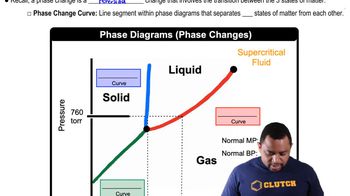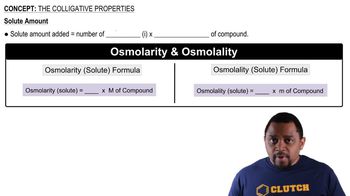The figure shows two identical volumetric flasks containing the same solution at two temperatures. (b) Does the molality of the solution change with the change in temperature? [Section 13.4]
Ch.13 - Properties of Solutions

Brown14th EditionChemistry: The Central ScienceISBN: 9780134414232Not the one you use?Change textbook
Chapter 13, Problem 10b
This portion of a phase diagram shows the vapor–pressure curves of a volatile solvent and of a solution of that solvent containing a nonvolatile solute. (b) What are the normal boiling points of the solvent and the solution? [Section 13.5]
 Verified step by step guidance
Verified step by step guidance1
Identify the phase diagram provided in the problem, focusing on the vapor-pressure curves for both the pure solvent and the solution.
Recall that the normal boiling point of a substance is the temperature at which its vapor pressure equals 1 atm (or 760 mmHg).
Locate the point on the vapor-pressure curve of the pure solvent where the pressure is 1 atm. The corresponding temperature is the normal boiling point of the solvent.
Similarly, locate the point on the vapor-pressure curve of the solution where the pressure is 1 atm. The corresponding temperature is the normal boiling point of the solution.
Note that the presence of a nonvolatile solute typically lowers the vapor pressure of the solution, resulting in a higher boiling point compared to the pure solvent. This phenomenon is known as boiling point elevation.

Verified video answer for a similar problem:
This video solution was recommended by our tutors as helpful for the problem above.
Video duration:
1mWas this helpful?
Key Concepts
Here are the essential concepts you must grasp in order to answer the question correctly.
Phase Diagram
A phase diagram is a graphical representation that shows the phases of a substance at various temperatures and pressures. It illustrates the conditions under which distinct phases, such as solid, liquid, and gas, coexist. Understanding phase diagrams is crucial for interpreting the behavior of substances, particularly in relation to boiling points and vapor pressures.
Recommended video:
Guided course

Phase Changes in Diagrams
Vapor Pressure
Vapor pressure is the pressure exerted by a vapor in equilibrium with its liquid or solid form at a given temperature. It indicates how readily a substance will evaporate and is a key factor in determining boiling points. The normal boiling point of a liquid is defined as the temperature at which its vapor pressure equals atmospheric pressure, typically 1 atm.
Recommended video:
Guided course

Raoult's Law and Vapor Pressure
Colligative Properties
Colligative properties are properties of solutions that depend on the number of solute particles in a given amount of solvent, rather than the identity of the solute. These properties include boiling point elevation and freezing point depression. When a nonvolatile solute is added to a solvent, the boiling point of the solution increases compared to that of the pure solvent, which is essential for determining the boiling points in the given question.
Recommended video:
Guided course

Colligative Properties
Related Practice
Textbook Question
1
views
Textbook Question
Suppose you had a balloon made of some highly flexible semipermeable membrane. The balloon is filled completely with a 0.2 M solution of some solute and is submerged in a 0.1 M solution of the same solute:
Initially, the volume of solution in the balloon is 0.25 L. Assuming the volume outside the semipermeable membrane is large, as the illustration shows, what would you expect for the solution volume inside the balloon once the system has come to equilibrium through osmosis? [Section 13.5]
Textbook Question
Which diagram best represents a liquid–liquid emulsion such as milk? The colored balls represent different liquid molecules. [Section 13.6]
